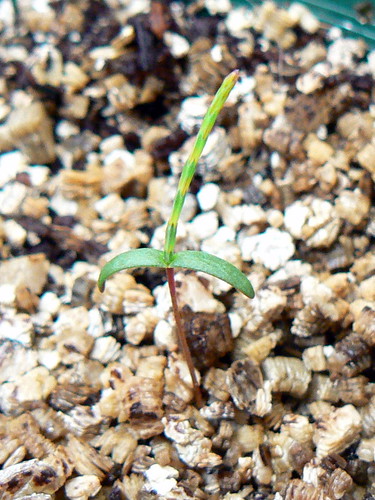In both cases, the contrast between the cotyledons (embryonic leaves) and the first "true leaves" is stark. In dicotyledons, the two cotyledons form inside the embryo inside the seed and emerge after germination. They are soon replaced by leaves that are much closer in structure to those of the mature plant.
In the Allocasuarina littoralis, the small scale-like leaves are already visible along the main stem. The specimen above is around 3 cm tall.

The true leaves of the Hakea sericea display the sharp needle-like structure of mature leaves, but are still very soft in comparison with the brutal barbs it'll have when it grows up.
When all the seedlings have reached around 10 cm in height, I'll pot them up into tube stock tubes, and move them out of the glass house, and put them into the shade house. That will give them time to harden up in a relatively sheltered environment, and perhaps be ready to go in the garden by next autumn.
When all the seedlings have reached around 10 cm in height, I'll pot them up into tube stock tubes, and move them out of the glass house, and put them into the shade house. That will give them time to harden up in a relatively sheltered environment, and perhaps be ready to go in the garden by next autumn.

4 comments:
fascinating to see the leaves at this early stage
Sure is, Greenspace. It's remarkable to think that the "fatemap" of the plant is already starting to be realised, and it's all destined by the genes in the seed and their expression. Two seeds might look identical, their cotyledons showing little variation, and then the true leaves emerge and suddenly there is such variety!
Lovely clear shots
Sitting in a hotel room in LA browsing the net and came across your amazing site. Keep it up, we live in Berrilee so of course your site is a 'professional' view of our backyard. Fascinating reading...
Post a Comment